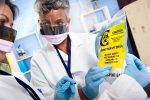
| Pharmacist Key Stats | |
|---|---|
| Education | 3-4 Years |
| Job Outlook | -2% |
A pharmacist is a health care professional who prepares and dispenses drugs, and also gives health advices to clients.
You might like to become a pharmacist if you are interested in health, along with biology and chemistry, and would like a career where you can work with people.
Many people who are looking for a career in medicine, but do not want to work in the high-stress environment of a hospital, choose a career in pharmacy.
The main responsibility of a pharmacist is to fill prescriptions that patients bring in.
This may seem like a simple task, however a pharmacist must have a wide understanding of different drugs and the way they affect our bodies.
They are often called upon to give advice to patients about their prescriptions, as well as general health and wellbeing advice.
Table of Contents
Education Requirements to Become a Pharmacist
Your journey to become a pharmacist can begin when you are still in high school.
Taking subjects in math, chemistry, physics, and biology will help you to secure a place at a good college.
You will also need strong writing skills, so concentrate on getting good grades in English.
To become a pharmacist, you’ll need a doctorate of pharmacy.
There are two pathways to achieve this degree.
You can either enter a six year program right after high school which will cover all the coursework you need to become an accredited pharmacist.
The second option is to complete a four year undergraduate degree, followed by a shortened doctorate of pharmacy program.
This takes between three and four years to complete.
When you are looking for schools, it’s important to select one that is accredited by the ACPE, or the Accreditation Council for Pharmacy Education.
In all states, pharmacists need to be licensed before they can practice.
In most, but not all, places, the standard exam is the North American Pharmacist Licensure Exam, or NAPLEX.
In some states, you may need to take the NAPLEX, along with another state set exam.
Pharmacist Job Description
A pharmacist’s main responsibility is to prepare and distribute drugs.
They will also speak with clients, giving them information and instructions about the drugs they are taking.
Often people with health complaints will ask a pharmacist for advice, rather than seeing a doctor.
While you need to be good at studying to become a pharmacist, you also need good people skills.
A pharmacist may work at a large retail store pharmacy, or in smaller retail shops.
This could involve spending a good amount of your day speaking with clients about their medical problems, keeping an inventory, working a register, and keeping records.
Some pharmacists work in hospitals, others in research sectors.
In recent years, pharmacists have become more involved in developing drug therapy programs for patients, and have also given counseling when it has been required.
Here are some of the common tasks a pharmacist may complete:
- Preparing prescription drugs
- Filling prescriptions
- Communicating with customers
- Giving health advice
- Keeping and inventory of drugs and shop stock
- Operating a register
- Preparing drug therapy programs
Pharmacist Salary and Career Path
Most pharmacists will get their first job working in a pharmacy.
They may be working in a retail shop, or as part of a hospital.
Some pharmacists also work in research sectors, conducting trials on new drugs.
Some may work in labs, manufacturing drugs from scratch.
Usually a new pharmacist will work under a more experienced pharmacist for the first few years of their career, before branching out into more complicated positions with greater responsibility.
Many go on to open their own pharmacies and enjoy the opportunity to own and run their own businesses.
Most pharmacists earn between $92,000 and $120,000 a year.
The median wage is around $106,000 a year.
The top 10% of pharmacists earn more than $130,000 a year.
Some positions a pharmacist may move onto later in their career include:
- Medical Doctor
- Medical researcher
- Biological Scientist
- Pharmaceutical researcher
- Pharmaceutical manufacturer
- Veterinary pharmacist
When you become a pharmacist, you can look forward to strong job opportunities.
With aging populations in the horizon, growth in this area is faster than in other industries.
If you are interested in health and medicine, and would like a challenging career in a growing industry, then pharmacy might be the perfect choice for you.
![]() The below information is based on the 2023 BLS national averages.
The below information is based on the 2023 BLS national averages.
National Average Salary
$134,790Average Salary by State
| State | Avg. Annual Salary |
|---|---|
| Alabama | $126,960 |
| Alaska | $151,600 |
| Arizona | $133,800 |
| Arkansas | $128,600 |
| California | $157,280 |
| Colorado | $141,670 |
| Connecticut | $133,490 |
| Delaware | $137,430 |
| District of Columbia | $138,110 |
| Florida | $128,190 |
| Georgia | $128,220 |
| Hawaii | $138,390 |
| Idaho | $129,140 |
| Illinois | $133,050 |
| Indiana | $130,600 |
| Iowa | $127,780 |
| Kansas | $129,300 |
| Kentucky | $131,020 |
| Louisiana | $124,770 |
| Maine | $133,540 |
| Maryland | $132,530 |
| Massachusetts | $128,580 |
| Michigan | $128,860 |
| Minnesota | $143,210 |
| Mississippi | $125,330 |
| Missouri | $132,570 |
| Montana | $131,260 |
| Nebraska | $130,120 |
| Nevada | $131,820 |
| New Hampshire | $139,560 |
| New Jersey | $130,390 |
| New Mexico | $131,420 |
| New York | $133,040 |
| North Carolina | $134,600 |
| North Dakota | $127,260 |
| Ohio | $124,850 |
| Oklahoma | $125,710 |
| Oregon | $149,550 |
| Pennsylvania | $131,200 |
| Rhode Island | $113,110 |
| South Carolina | $134,960 |
| South Dakota | $135,030 |
| Tennessee | $122,820 |
| Texas | $133,600 |
| Utah | $130,770 |
| Vermont | $140,010 |
| Virginia | $138,390 |
| Washington | $148,550 |
| West Virginia | $121,000 |
| Wisconsin | $139,980 |
| Wyoming | $135,190 |
| Guam | $113,010 |
| Puerto Rico | $99,140 |
| Virgin Islands | $119,970 |
The top earning state in the field is California, where the average salary is $157,280.
These are the top 5 highest-paying states in the field:
* Employment conditions in your area may vary.
Frequently Asked Questions
What does a pharmacist do?
Pharmacists supply medication to patients and offer guidance in the safe use of those medications.
Depending on your place of employment, you may have to fulfill additional roles, for example, if you are a community pharmacist, you may give immunization such as flu shots.
As a pharmacist, you can find employment in different places.
You can work as a clinical pharmacist in which position you can create compounding medication, mixing different chemical ingredients to create customized medication.
You can also work in a chain of pharmacies as a community pharmacist and your role will be to dispense medication to your customers and give guidance regarding over-the-counter medication.
If you want to work in research and development of new medications as a pharmaceutical industry pharmacist you will be responsible for designing and conducting blind clinical trials to help establish the efficiency of new drugs.
Regardless of the path you decide to pursue, as a pharmacist you need to have great verbal and written skills, organizational abilities and attention to detail.
How much does a pharmacist make?
According to the Bureau of Labor Statistics (BLS), the median annual wage for pharmacists was $126,120 in May 2018.
Salaries vary based on a wide range of factors and some pharmacists make less than $90,000, while others make more than $160,000 a year.
How much does it cost to become a pharmacist?
To become a pharmacist you will need to complete a graduate program and earn your Pharm D. Degree.
On average, it can cost you between $65,000 and $200,000 to earn your pharmacy degree.
Before enrolling at a Pharm. D. program you must complete around four years of undergraduate coursework.
If we also take into account the cost of completing your undergraduate studies, becoming a pharmacist can be quite expensive, especially if you don’t receive a scholarship.
The good news is that this job can help you cover your educational costs a few years after finding employment.
According to the 2014 National Pharmacist Workforce Survey, pharmacists with five years or less of experience reported having paid as much as a third of the student loan debts.
What is the demand for pharmacists?
The employment of pharmacists is projected to show little or no change in the following years, according to BLS.
This is due to the fact that most of our drugs can be bought from an online pharmacy and many pharmacy operations can be performed by pharmacy technicians.
However, pharmacists will still be needed in healthcare facilities to oversee what medication is given to patients.
How long does it take to become a pharmacist?
You have to get a Doctor of Pharmacy (Pharm.D.) degree from an accredited pharmacy program in order to become a pharmacist.
To enroll in a pharmacy program you need at least 2 years of undergraduate studies.
Most pharmacy programs require applicants to also hold a bachelor’s degree, which usually takes 4 years to complete.
A Pharm.D program takes 4 years to finish, although there are programs who last only 3 years.
Some colleges also offer mixed programs that can be completed by high school graduates and these programs are usually 6 years long.
After earning your degree, you will also need a license because all states require pharmacists to be licensed.













